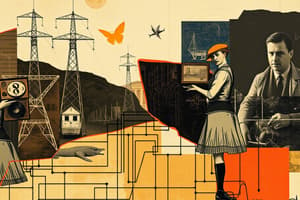Podcast
Questions and Answers
What is Ohm’s Law?
What is Ohm’s Law?
Ohm's Law describes the relationship between voltage, current, and resistance, stating that current is proportional to voltage with resistance as the constant of proportionality.
In which year did Georg Simon Ohm publish the results known as Ohm's Law?
In which year did Georg Simon Ohm publish the results known as Ohm's Law?
- 1854
- 1830
- 1827 (correct)
- 1826
A capacitor is characterized by its ability to store electric power.
A capacitor is characterized by its ability to store electric power.
False (B)
What is the SI unit for measuring electric current?
What is the SI unit for measuring electric current?
What type of circuit is a series circuit?
What type of circuit is a series circuit?
What is the primary function of a resistor in an electric circuit?
What is the primary function of a resistor in an electric circuit?
What does voltage do in an electrical circuit?
What does voltage do in an electrical circuit?
A _____ is a semiconductor device used to amplify or switch electronic signals.
A _____ is a semiconductor device used to amplify or switch electronic signals.
What is the key difference between metal film and carbon film resistors?
What is the key difference between metal film and carbon film resistors?
In parallel circuits, current can flow even if there is a break in one branch.
In parallel circuits, current can flow even if there is a break in one branch.
Flashcards are hidden until you start studying
Study Notes
Ohm's Law
- Ohm's Law defines the relationship between voltage, current, and resistance in electrical circuits.
- Current is directly proportional to voltage, with resistance as the constant factor.
Electric Circuit
- An electric circuit is a complete conductive loop allowing the flow of electric charge.
- Components include batteries, resistors, inductors, capacitors, switches, and transistors.
Transistor
- Transistors are semiconductor devices used for amplifying or switching electronic signals and power.
- They are fundamental to modern electronic devices.
Capacitors
- Capacitors store electric charge and are key components in various electronic applications.
Inductors
- Inductors are passive components that store energy in magnetic form when current flows through them.
History of Ohm's Law
- Georg Simon Ohm (1789 - 1854), a German physicist, established Ohm's Law through experiments in 1826 and 1827.
- He utilized a galvanometer to measure current and investigate voltage differences.
Voltage
- Voltage acts as the driving force, pushing electric charges through conductors.
- Conductors are materials that allow the transfer of electricity, heat, or sound.
Current
- Electric current is the flow of charge carriers, such as electrons, moving from negative to positive points.
- Measured in amperes (A), current is essential for circuit functioning.
Resistance
- Resistance hinders the free flow of electrons in a conductor, causing energy loss as heat.
- Resistors are used to introduce specific resistance values in circuits, controlling current and voltage.
Types of Resistors
- Metal film resistors use a precise metal film for resistance, while carbon film resistors utilize carbon film.
Activity Materials
- Required materials include Arduino UNO, breadboard, jumper wires, battery, LED, 220k resistor, and a switch.
Series Circuit
- A series circuit consists of a single loop where current flows through all components sequentially.
Parallel Circuit
- Parallel circuits feature multiple branches allowing current to flow even when one branch is interrupted.
- Each branch operates independently, improving circuit resilience.
Studying That Suits You
Use AI to generate personalized quizzes and flashcards to suit your learning preferences.



